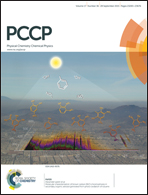Hyperconjugation in diethyl ether cation versus diethyl sulfide cation†
Abstract
Ionization of a molecule can greatly alter its electronic structure as well as its geometric structure. In this collaborative experimental and theoretical study, we examined variance in hyperconjugation upon ionization of diethyl ether (DEE) and diethyl sulfide (DES). We obtained the experimental gas phase vibrational spectra of DEE, DES, DEE+, DES+, DEE+–Ar, and DES+–Ar in the wavenumber region of 2500 to 3600 cm−1. For DEE+ and DEE+–Ar, we observed a greatly red shifted CH stretching peak at 2700 cm−1, while the lowest CH stretching peaks for DEE, DES, DES+ and DES+–Ar were observed around 2850 cm−1. For DEE+, we calculated a drastic red shifted CH stretching peak at 2760 cm−1, but for DEE, DES, and DES+ the lowest CH stretching peaks were calculated to be at 2860, 2945, and 2908 cm−1, respectively. In addition, for DEE, the minima (maxima) geometry in the neutral state becomes a maxima (minima) geometry in the cationic state, while similar minima geometries are seen in neutral and cationic states of DES. These experimental and theoretical findings were rationalized through the natural bond orbital analysis by quantifying the hyperconjugation between the σCH orbital and the ionized singly occupied p orbital of the oxygen (sulfur) in DEE+ (DES+). This study showed how orientation with the ionized orbital can greatly affect the neighboring CH bond strength and its polarity, as well as the geometry of the system. Furthermore, this change in the CH bond strength between DEE+ and DES+ is quantified from the energies for intramolecular proton transfer in the two cations.


 Please wait while we load your content...
Please wait while we load your content...